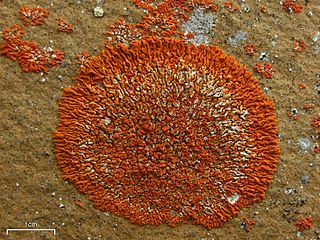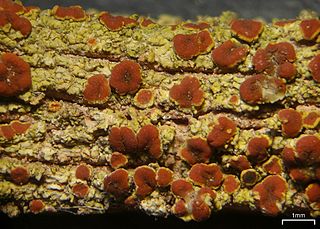Neobrownliella brownlieae is a species of saxicolous (rock-dwelling), crustose lichen in the family Teloschistaceae. It is widely distributed in Australia.
Sirenophila is a genus of crustose lichens in the subfamily Teloschistoideae of the family Teloschistaceae. It has four species with an Australasian distribution.
Neobrownliella is a genus of crustose lichens in the subfamily Teloschistoideae of the family Teloschistaceae. It has five species. The genus was circumscribed in 2015 by lichenologists Sergey Kondratyuk, Jack Elix, Ingvar Kärnefelt, and Arne Thell, with Neobrownliella brownlieae assigned as the type species. It is a segregate of the large genus Caloplaca. Characteristics of Neobrownliella include a thallus that is continuous or areolate, the presence of anthraquinones as lichen products, a cortical layer with a palisade paraplectenchyma, and the lack of a thick palisade cortical layer on the underside of the thalline exciple. Two species were included in the original circumscription of the genus; an additional three species were added in 2020.
Elixjohnia is a genus of lichen-forming fungi in the family Teloschistaceae. It has four species of saxicolous (rock-dwelling), crustose lichens that occur in Australasia.

Rusavskia is a genus of lichen-forming fungi in the family Teloschistaceae. It has 12 species. It is a member of the subfamily Xanthorioideae. The thallus of Rusavskia is characterized by its foliose (leaf-like) structure with distinct and typically narrow lobes that curve outwards.

Opeltia is a genus of lichen-forming fungi in the family Teloschistaceae. It has four species of corticolous (bark-dwelling), crustose lichens.
Fauriea is a genus of lichen-forming fungi in the family Teloschistaceae. The genus, which contains seven species, is a member of the subfamily Caloplacoideae.
Marchantiana is a genus of lichen-forming fungi in the family Teloschistaceae. It contains seven species of corticolous (bark-dwelling), crustose lichens that occur in the Southern Hemisphere.
Hosseusiella is a genus of lichen-forming fungi in the family Teloschistaceae. It has three species of crustose to foliose (leafy) lichens, some of which grow on bark, while others grow on rock. All three occur in the southern part of the South American continent, where they are fairly common.
Rehmanniella is a genus of lichen-forming fungi in the family Teloschistaceae. It contains five species of saxicolous (rock-dwelling) crustose lichens. The genus was circumscribed by lichenologists Sergey Kondratyuk and Jae-Seoun Hur in 2018. The genus name honours Polish geographer, geomorphologist, botanist and explorer Anton Rehmann (1840–1917), who collected bryophytes and vascular plants in South Africa. The genus was originally circumscribed with Rehmanniella wirthii assigned as the type and only species. Four additional species were added to the genus in 2020.
Orientophila is a genus of lichen-forming fungi in the family Teloschistaceae. It has 15 species of mostly saxicolous (rock-dwelling), crustose lichens. All Orientophila species occur in Northeast Asia including China, Japan, South Korea, and the Russian Far East.
Xanthaptychia is a genus of lichen-forming fungi in the family Teloschistaceae. The genus, circumscribed in 2017, has three corticolous (bark-dwelling) species.
Franwilsia is a genus of lichen-forming fungi in the family Teloschistaceae. It has three species.
Upretia is a genus of lichen-forming fungi in the family Teloschistaceae. It has three species of saxicolous (rock-dwelling), crustose lichens. Upretia is characterised by its small ascospores and narrow, rod-shaped conidia. The distribution of the genus ranges from mid-altitude rocky terrains in India to both arid and higher altitudinal environments in China.
Elixjohnia bermaguiana is a species of saxicolous (rock-dwelling), crustose lichen in the family Teloschistaceae. It is found in Australia. The lichen is characterised by its varying areoles, which are thin to moderately thick, flat to slightly convex, and range from bright yellow to whitish in colour, sometimes with a greenish-yellow hue. Its apothecia are small, with a distinct orange margin and a raised brownish-orange or yellowish-brown disc.
Elixjohnia gallowayi is a species of saxicolous (rock-dwelling), crustose lichen in the family Teloschistaceae. It has a vividly coloured thallus, ranging in hues from bright red to reddish-orange. It is found in Australia.
Fauriea trassii is a lichen species in the family Teloschistaceae, described in 2011. It is primarily found in the Far East of Russia, particularly in the Primorsky Krai region.
Gintarasiella is a single-species genus in the fungal family Teloschistaceae. It contains the species Gintarasiella aggregata, a saxicolous (rock-dwelling), crustose lichen that is found in Australia. The lichen forms uneven, pillow-like patches up to 30 mm across, distinguished by its yellow-orange areoles that are tightly packed or spread out and soon covered by many apothecia. These fruiting bodies start as zeorine in form and later become biatorine, ranging from 0.3 to 1 mm wide and often appearing distorted due to their dense clustering.
Lazarenkoiopsis is a single-species fungal genus in the family Teloschistaceae. It contains Lazarenkoiopsis ussuriensis, a corticolous (bark-dwelling), crustose lichen species found in the Russian Far East.
Elixjohnia jackelixii is a species of saxicolous (rock-dwelling), crustose lichen in the family Teloschistaceae. It is found in Australia and New Zealand. The lichen is characterised by its unique multilayered appearance with outer sterile rings that are brownish or greenish-yellow and inner areoles that are whitish, yellowish, or greyish, often cracked to reveal the medulla underneath. Its fruiting bodies, or apothecia, are typically attached directly to the thallus and vary in colour and shape.

